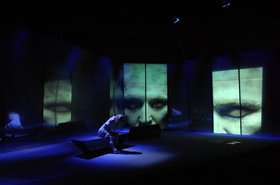The curtain rises like a heavy tombstone to reveal a women sitting on a bench, her feet turned inward, her head looking away, motionless. Gradually, an image of her face fades into focus on the back wall. Serene and ashen, she could be dead. But suddenly, water breaks from the skies, and the figure preserved in salt for thousands of years is slowly washed back to life. “Sodome – city of joy and excess,” she exclaims, before leading us through the story of how she came to appear before us.
Written by Laurent Gaudé, and translated and performed by Olwen Fouéré, Sodome, My Love captures the last days of Sodom, one of a number of cities reputed to be destroyed by God for the carnal sins of its people. In the Biblical account, Lot’s wife was turned into a pillar of salt for looking back at the city instead of walking on, rejecting it and all that it stood for. In Gaudé’s version of events, Lot’s wife, or someone like her, is revived to recount the loves and losses of her people.
In an earnest, vivid rendition, we learn that all was going well until the city’s inhabitants were deliberately “contaminated” by the Ambassador. Soon, a virus began to spread among men and women, resulting in lesions, necrosis and eventually excruciating death. Gaudé’s particular take of the last days of Sodom, juxtaposed against projections of swirling blood, makes us think not only of the curtailment of female sexuality, but more pointedly of illnesses such as HIV/AIDS and the rightist religious rhetoric that imagines it as a curse from God. Fouéré’s character does not know why she alone was protected from infection. But she is certain that her conscious paralysis was infinitely worse.
 Fouéré’s voice is her most powerful instrument in imparting this tale: deeply textured, crystal clear, and resonant. She recites a monologue over the course of eighty minutes, her body dipping in and out of a series of awkward poses. A solid, slightly skewed backdrop carries a series of evocative images to animate the narrative – smoke rising, traffic moving, neon lights flashing. Both Fouéré’s voice and the staging work well to enliven the story, and to create a sense of momentum.
Fouéré’s voice is her most powerful instrument in imparting this tale: deeply textured, crystal clear, and resonant. She recites a monologue over the course of eighty minutes, her body dipping in and out of a series of awkward poses. A solid, slightly skewed backdrop carries a series of evocative images to animate the narrative – smoke rising, traffic moving, neon lights flashing. Both Fouéré’s voice and the staging work well to enliven the story, and to create a sense of momentum.
Despite the impact of these theatrical choices, it still feels like the performance operates within a narrow affective register. This has something to do with the question of exchange: as an audience, we expect to be exposed to a sizable share of the terrific and terrifying sensations of which Fouéré’s character speaks, but this never really happens. As an actress, Fouéré is certainly capable of taking her character to this place, but neither the script nor the production is keen to do so. What we get instead are some rich memories and interesting metaphors that struggle to seem urgent beyond the historical moment of devastation.
Seemingly anxious of the play's relationship to the present, director Lynne Parker shifts the tone of the performance in the last ten minutes, when Fouéré has finished remembering, and is ready to face the world again. Her character plans to continue contaminating, although it remains unclear whether she hopes to produce joy or more illness. She removes some clothes from beneath a bench and slowly dresses. A black bob, stiletto ankle boots, sunglasses and a camel mac make up her new look. Now, she appears more like a postmodern Hollywood femme fatale (think Uma Thurman as Mia Wallace in Pulp Fiction) than an insurgent siren.
As she strides around the stage, foretelling all that she will do in the name of Sodom, images of other sexually overt females and their fans are projected across the set, notably Rosanna Davidson, Beyoncé, and footage of Fouéré herself from other incarnations. From a feminist perspective at least, the politics are a little more ambiguous at this point, and it is not easy to discern an obvious link between the sexuality of the women of Sodom and some of these pop icons. (Well, Beyoncé I can just about fathom.) You have to ask whether forms of femininity that have such commercial value can really be considered as threatening or revolutionary? Or are these images examples of a different kind of corruption? Are they just representatives of women who drive men crazy? Presumably a decision was made to forge a connection between the destruction of the women of Sodom with the unbridled sexuality of more contemporary figures. However, while ample resonance might be found in looking at the ways in which ideas of femininity are exploited in the present, not to mention how women are abused, the closing sequence confuses the politics of the piece. Fouéré walks off the stage and toward the main exit with a strangely mocking swagger.
Fintan Walsh is a post-doctoral research fellow at the Samuel Beckett Centre, Trinity College Dublin.